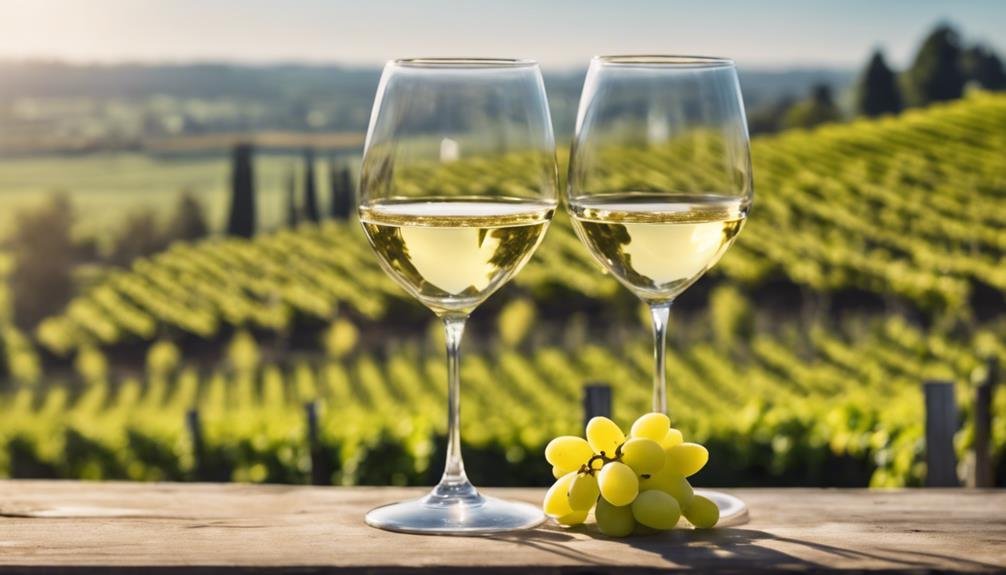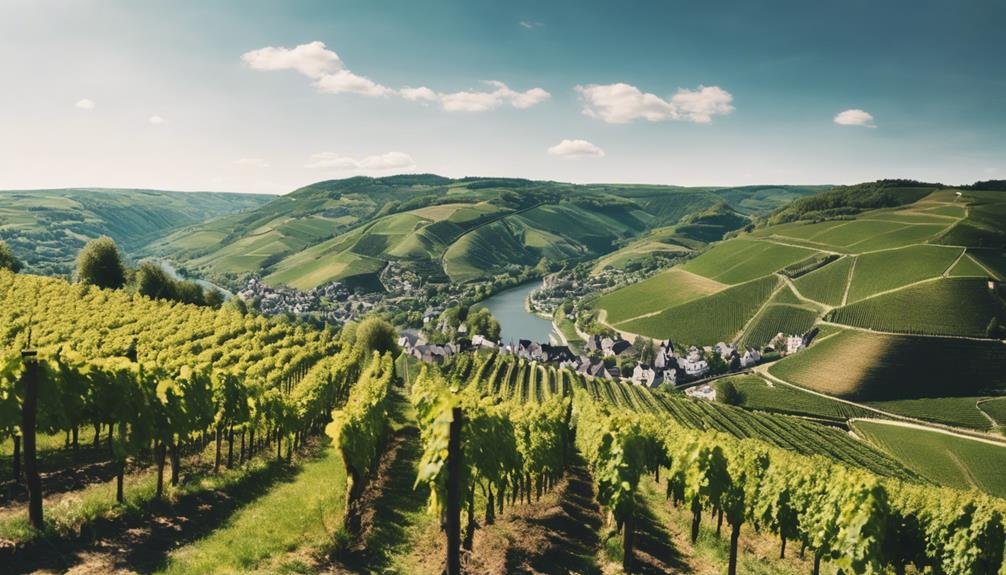Delve into a journey into the diverse world of German white wines. Explore refined Rieslings with evolving dry styles and high acidity for balance. Discover Müller-Thurgau, a floral gem blending Riesling's essence. Delight in the distinctiveness of Pinot Gris and Blanc, perfect for seafood or chicken dishes. Reveal the hidden treasure of Silvaner, with peachy flavors and herbaceous notes. Traverse regions like Mosel, Rheinhessen, and Baden, each defining Germany's terroir diversity. Each sip uncovers a unique landscape of flavors and traditions awaiting your palate, showcasing Germany's rich winemaking heritage.
German Riesling: The Quintessential White Wine
German Riesling stands as the epitome of refined elegance and unparalleled quality in the world of white wines. This grape variety is known for its evolving styles, with a shift towards more dry expressions in recent years.
One of the key characteristics of German Riesling is its high acidity, which plays a vital role in balancing the sweetness often found in these wines. Understanding the various classifications of German Riesling is essential for enthusiasts seeking their preferred style.
Regions like Mosel, Rheingau, and Pfalz showcase the diversity and terroir-driven nuances of German Riesling, offering a wide range of flavors and aromas to explore. Embracing the complexity and acidity balancing act of German Riesling can lead to a deep appreciation for this quintessential white wine.
Müller-Thurgau: Germanys Everyday Gem
Regarded as a staple in the world of German white wines, Müller-Thurgau embodies an everyday gem appreciated for its approachable characteristics and floral aromatics. This grape variety offers everyday elegance with a more under-appreciated charm compared to its renowned counterpart, Riesling.
Müller-Thurgau, a cross between Riesling and Madeleine Royale, produces full-bodied wines that exhibit a unique floral profile, making it a delightful choice for those seeking a versatile and easy-to-drink white wine. Despite its under-the-radar status, quality examples of Müller-Thurgau can be found in specific regions in Germany, showcasing its potential to surprise and impress.
Embrace the allure of Müller-Thurgau for a taste of German winemaking tradition with a touch of everyday sophistication.
Pinot Gris and Pinot Blanc: Elegant Varietals

Pinot Gris and Pinot Blanc stand out as elegant varietals renowned for their distinct characteristics and versatility in the world of white wines. These wines offer a delightful experience with their unique profiles:
- Food Pairings and Tasting Notes:
Pinot Gris pairs excellently with seafood dishes like grilled shrimp or scallops due to its crisp acidity and notes of pear and apple. On the other hand, Pinot Blanc complements dishes like roasted chicken with its smooth texture and flavors of citrus and almond.
- Aging Potential and Vineyard Profiles:
Pinot Gris can age gracefully for 3-5 years, evolving to showcase richer textures and honeyed notes. Vineyards in regions like Pfalz and Baden excel in cultivating these varietals, capturing the essence of the terroir in each bottle.
Silvaner: The Hidden White Wine Jewel
Silvaner emerges as a bewitching white wine varietal, revered for its elusive allure and exceptional quality within the diverse landscape of German white wines. This underrated grape, despite being the 4th most planted white wine in Germany, remains undiscovered outside the country.
Silvaner wines are known for their high quality, boasting peachy and passion fruit flavors complemented by herbaceous notes. Regions like Rheinhessen and Franken excel in producing excellent Silvaner wines, showcasing the grape's potential.
While challenging to cultivate, the rewards of Silvaner lie in its unique and delightful characteristics, making it a hidden gem waiting to be explored by wine enthusiasts seeking something beyond the ordinary.
Exploring Germanys White Wine Regions

Germany's diverse wine regions offer a rich tapestry of unique expressions in their white wines, showcasing the country's viticultural prowess and terroir diversity.
Exploring German White Wine Regions:
- Mosel: Known for its steep vineyards along the Mosel River, producing vibrant Rieslings with racy acidity.
- Rheinhessen: Germany's largest wine region, home to a variety of indigenous grapes like Silvaner and Müller-Thurgau.
- Baden: Located in the southwest, this region is famous for Grauburgunder and Weissburgunder wines, displaying a balance of fruitiness and minerality.
Exploring these regions reveals Germany's unique terroirs, each contributing to the cultivation of indigenous varietals that define the country's white wine landscape.
Frequently Asked Questions
What Food Pairings Best Complement German Riesling Wines?
When considering Riesling pairings, understanding its diverse flavor profiles is essential. Its high acidity and sweetness make it versatile, complementing spicy dishes, Asian cuisines, and rich cheeses. Riesling's balance elevates seafood, poultry, and dishes with a hint of sweetness.
How Does the Taste of Müller-Thurgau Differ From Riesling?
When comparing Müller-Thurgau to Riesling, Müller-Thurgau tends to offer a more approachable profile with floral aromatics and a fuller body, while Riesling showcases higher acidity and a broader range of flavors, from zesty citrus to tropical fruits.
Are Pinot Gris and Pinot Blanc Suitable for Aging?
Pinot Gris and Pinot Blanc both have aging potential, with Pinot Gris showing better longevity. Pinot Gris offers richer, fuller-bodied wines with honeyed notes, suitable for aging. Pinot Blanc, with its softer acidity and stone-fruit flavors, can also benefit from aging.
What Sets Silvaner Apart From Other German White Wines?
Silvaner stands out among German white wines due to its distinctive profile characterized by peachy, passion fruit flavors with herbaceous notes. Terroir influences play a significant role in shaping Silvaner's unique expression, especially in regions like Rheinhessen and Franken.
Which Lesser-Known German Regions Produce Exceptional White Wines?
Lesser-known German regions like the Mosel terroir and Elbling revival areas produce exceptional white wines. These regions offer unique expressions of German winemaking, showcasing diverse terroirs and grape varieties that contribute to the country's rich viticultural landscape.
Conclusion
To wrap up, German white wines offer a diverse and intriguing array of varietals, showcasing the country's winemaking prowess.
One interesting statistic to note is that Riesling accounts for over 20% of Germany's vineyard area, highlighting its importance in the country's wine production.
Explore the rich tapestry of German white wines and immerse yourself in the world of excellence that these remarkable varietals have to offer.